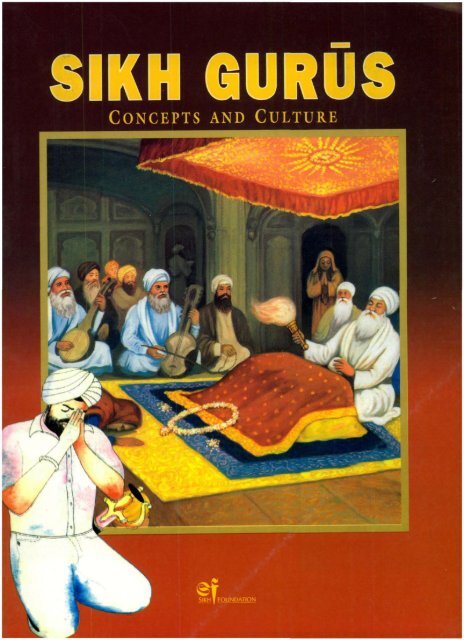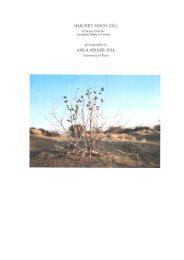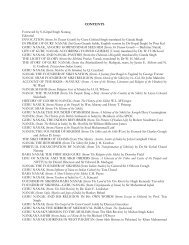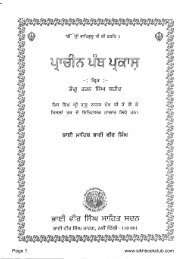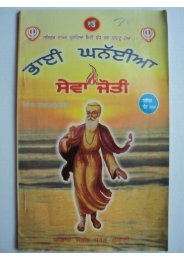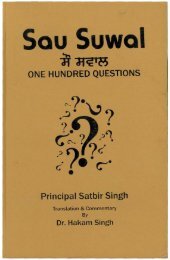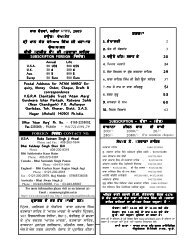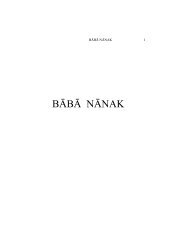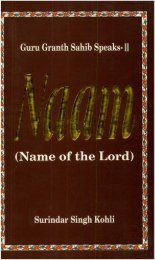Sikh.Gurus.Concepts... - Gurmat Veechar
Sikh.Gurus.Concepts... - Gurmat Veechar
Sikh.Gurus.Concepts... - Gurmat Veechar
Create successful ePaper yourself
Turn your PDF publications into a flip-book with our unique Google optimized e-Paper software.
Foreword<br />
As compared to other religions of the world, <strong>Sikh</strong> religion is new and unique. It flourished with the<br />
arrival of Guru Niinak Dev in this world, and the nine successor Guriis contributed a lot in the propagation<br />
of its theology, ethics and the doctrines of equality, freedom and brotherhood. This religion is not only<br />
unique because of its newness, but due to the fact that it made the people conscious about the difficulties of<br />
the modern age and established the concept of egalitarian human society. The effort made by the <strong>Gurus</strong> was<br />
like a revolution for the suffering humanity and the way of living put forth by it, broke all the barriers of<br />
caste and creed; thus embracing the people from all walks of life without any cliscrimination. The practical<br />
objectives accomplished by the <strong>Gurus</strong> for establishing lU1ity among the people could not be seen anywhere<br />
else in the society.<br />
Instead of believing the religion to be a part of one's life, Guru Sahib made it a tool for guidance in<br />
evety walk of social life. Guru Arjan Dev Ji presented the religion in the spiritual as well as in the form of<br />
virtuous conduct and stated :<br />
Sarab dharma mam sresata dharamu. Hari ko niimu japi nirmala karama.<br />
Of all religions, the best religion is to chant the Name of the Lord and maintain pure conduct.<br />
(SGGS pg. 266)<br />
Religion affects the life of every inclividual and that is why this newly defined form of religion worked<br />
immensely in bringing the people of all lifestyles nearer to each other. For the propagation and application of<br />
religion among the entire humanity, clifferent institutions were established.<br />
As the <strong>Sikh</strong> society is deVeloping and acquiring new heights, there has been a rise in the queries<br />
regarcling the <strong>Sikh</strong> religion .in the people resieling in the country and overseas as well. Besides this, it is true<br />
that till date, the attempts made to establish the clistinct identity of <strong>Sikh</strong>ism have been incomplete. That's<br />
why there were attacks on the <strong>Sikh</strong> community in the western world, misunderstancling them as Arabs.<br />
Much has been written about the <strong>Sikh</strong> religion, but due to the lack of time and effort, the authenticated<br />
academic information present in the books has not reached the common person.<br />
To provide the basic information about the <strong>Sikh</strong> religion, this book prepared by Dr. Paramvir Singh<br />
briefly describes the <strong>Sikh</strong> history, ideology and its institutions, from which every reader can feel benefitted<br />
profusely. The detail presented in this small book is brief, but significant. No endeavor has been made to<br />
find something altogether new in this work and instead attempt has been made to provide authenticated and<br />
meaningful information about the <strong>Gurus</strong> and their tenets. <strong>Sikh</strong> Foundation has published this book and the<br />
work in hand provides reliable information about <strong>Sikh</strong> faith, its concepts, culture and the <strong>Sikh</strong> tradition.<br />
Dr. Jodh Singh<br />
Professor,<br />
Department of Guru Granth Sah.ib Sntdies,<br />
PWljabi University, Pa~i:ila<br />
SIKH GURUS, <strong>Concepts</strong> and Culture<br />
First Published in India in October 2008 by SIKH FOUNDATION<br />
Author'<br />
Dr. Paramvir Singh Guru Gobind Singh Department of Rellgious Srudies, Punjabi University, Patiala<br />
Edit & Design .<br />
Baljit Singh, Inderjeet Singh<br />
Photographs Courtesy . P&SB, DSGMC, SGPC, Gagandecp Singh<br />
Managed, Created & Published by .<br />
SIKH FOUNDATION A-35 Lajp" Nagar-I, N
GurU<br />
Guru means a spiritual guide or preceptor. He is the nucleus of <strong>Sikh</strong> way of life.<br />
The word 'Guru' has been used in <strong>Gurmat</strong> for the Lord Almighty. The Supreme Being<br />
in the form of Guru guides a <strong>Sikh</strong>, leads him toward the religious pursuit and blesses him<br />
with the knowledge ofspiritual upliftment.<br />
There have been Ten <strong>Gurus</strong>, beginning from Guru Nanak Dev Ji to Guru Gobind Singh<br />
Ji. A <strong>Sikh</strong> regards all the <strong>Gurus</strong> as the effulgence of one light and one single entity. This jot<br />
or light is in the form of Shabad Guru. That's why 'Shabad' present in Guru Granth Sahib is<br />
referred to as the everlasting Guru of the <strong>Sikh</strong>s.<br />
Guru Nanak Sahib laid the foundation of <strong>Sikh</strong> religion who revealed the Shabad in the<br />
form of Guru. In 1708 AD, Guru Gobind Singh Ji bowed before the Shabad Guru, Guru<br />
Granth Sahib, instructed the <strong>Sikh</strong>s to revere it as their Guru and<br />
ordained that in future, the light of Guru would be in 'Granth'<br />
and form in the 'Panth'.<br />
The teachings of the <strong>Gurus</strong>, included in Guru Granth<br />
Sahib, are called GurbiiI)I. Therefore, GurbiiI)I is our<br />
Guru.<br />
Guru is like a river of flowing waves of pure water<br />
and the Shabad or GurbiiI)I, included in it, is the tool for<br />
the purity of the mind.<br />
<strong>Sikh</strong><br />
Any human being who faithfully believes in<br />
* One Immortal Being,<br />
* Ten <strong>Gurus</strong>, from Guru Nanak Dev Ji to Guru Gobind Singh Jj,<br />
* The Guru Granth Sahib,<br />
* The utterances and teachings of the ten <strong>Gurus</strong>,<br />
* The baptism bequeathed by the tenth Guru, and<br />
* Who does not owe allegiance to any other religion,<br />
is a <strong>Sikh</strong>.<br />
Literal meaning of a <strong>Sikh</strong> is the learner, who follows the teachings of his preceptor, and<br />
lives the life according to the tenets of the Guru.<br />
A <strong>Sikh</strong>: * Worships only the One Timeless Being and no god or goddess.<br />
* Regards the ten <strong>Gurus</strong> as the effulgence of one light and one single entity.<br />
* Lives in consonance with Guru's tenets.<br />
A <strong>Sikh</strong>'s life has two aspects: individual or personal and corporate or Panrruc.<br />
In complete form, <strong>Sikh</strong> is one different separate community, which has its<br />
own language, own culture, own histoty, own religious concepts and its own<br />
distinctive and unique identity.
Parkash<br />
Parents<br />
Sister<br />
GurU ke Mahal<br />
Sahibzade<br />
First Sermon<br />
Journeys<br />
Companion<br />
BaI)i<br />
Vars<br />
Main BaI)is<br />
Message<br />
Contributions<br />
City Founded<br />
Contemporary<br />
Rulers<br />
Entrustment of<br />
Gurgaddi<br />
Joti-jot<br />
Gurii Nanak Dev Ji<br />
In 1469 AD at Rai Bhoi ld Talwan9i (Now Nankiil)a Sahib, Pakistan)<br />
Mata Tripti and Mehta Kalyiil) Das Ji<br />
Bebe Nanald Ji<br />
Mata Sulakiu)l Ii<br />
Baba Sri Chand and Baba Lakhrni Das Ji<br />
In 1499 AD while living at Sultanpur LodhI, one morning GurU Sahib<br />
went to the rivulet Vein to take the bath, where He got immersed in<br />
Nam-Sirnran and was blessed with Divine Realization. Coming out of<br />
it, He gave His first sermon to the people 'Na ko Hindu na Musalman'<br />
Neither there is any Hindu nor Muslim, means all are children of One<br />
God.<br />
GurU Nanak Sahib undertook four journeys (Udasis) for the welfare of<br />
all, towards different directions. He travelled extensively throughout the<br />
Indian sub-continent and apart from India he visited Sri Lanka, Mecca<br />
(Saudi Arabia), Iraq, Iran and Afghanistan. He travelled for almost 22<br />
years. The purpose of these journeys was the welfare of humanity and to<br />
have a dialogue with other religious communities to reveal the way of<br />
truth.<br />
During these journeys, his companion was Bhiii Mardana; three Shabads<br />
are inscribed under his name in GurU Granth Sahib<br />
974 hymns recited in 19 ragas<br />
3 - in Majh, Asa and Malar ragas<br />
Japu, Asa ld Var, Pahare, AlahaJ!ia, Kuchaji, Suchaji, Pati, Thiti, Arti,<br />
DakhaI)i Oankar, Barah Maha, Sidh Gosti<br />
Recite Lord's Name, Do earnest earning and Share it with others<br />
* Establishment ofSailgat and Lailgar institutions<br />
* Chosing the leader from the Sailgat on the basis ofqualities<br />
* Collecting BaI)i and giving it the shape of a Poth!<br />
GurU Nanak Sahib founded Kartarpur, a city on the banks of river Ravi<br />
in 1504 AD.<br />
Bahilol LodhI (r. 1451-89 AD), Sikandar LodhI (r. 1489-1517<br />
AD), Ibrahim LodhI (r. 1517-30 AD), Babar (r. 1526-30 AD),<br />
Humayun (r. 1530-40 AD)<br />
Transformed Bhiii Le!u:J.a as 'Ailgad' and installed him as the second GurU<br />
of the <strong>Sikh</strong>s<br />
In 1539 AD at Kartarpur on the banks ofriver Ravi (now in Pakistan)<br />
Kalijugu babe taria sari niimu parhi rnantru sll1Jaia.<br />
Kali taran Guru Niinaku aia.<br />
Baba Niinak rescued this dark age and recited<br />
'Satnam' mantra for one and all.<br />
GurU Nanak came to redeemed the Kaliyug.<br />
(BhaJ Gurdas Jl. var I PaUli 23)
Parkash<br />
Parents<br />
Guru ke Mahal<br />
Sahibzade<br />
Sahibzaelian<br />
Accession to<br />
Gurgadeli<br />
BiiI)i<br />
Contributions<br />
Message<br />
Contemporary<br />
Rulers<br />
Entrustment of<br />
Gurgadeli<br />
Jod-jot<br />
GurU Angad Dev Ji<br />
In 1504 AD at Mane eli Sarai, district Firozpur, Panjab<br />
Mata Ram Kaur and Bhai Pheru Mall Ji<br />
Mata Khivi Ji<br />
Baba DatU and Baba Dasu Ji<br />
Bibi Anolli and Bibi Amro Ji<br />
In 1539 AD at Kartarpur on the banks of river Ravi<br />
63 SaJokas<br />
* Ratification of Gurmukhi script<br />
* Preservation of GurbiiI)i<br />
* Establishment of academic and physical training schools<br />
* Respect and recognition of the status of women in <strong>Sikh</strong> religion by<br />
appointing Mata Khivi as incharge of the Lailgar<br />
Selfless service and complete surrender to the Will of God<br />
Emperor Humayun (r. 1530-40 AD), Sher Shah Suri (r. 1542-45 AD),<br />
Islam Shah (r. 1545-53 AD)<br />
Nominated Guru Amar Das Ji as the third Guru of the <strong>Sikh</strong>s<br />
In 1552 AD at KhaQur Sahib, Panjab<br />
Lahane di pheraiai Nmill dohl khapai.<br />
Joti oha jugati siii sam kiii.. pheri palapai.<br />
Nanak proclaimed Leh1).a's succession - he earned it.<br />
They shared the One Light and the same way;<br />
the King JUSt changed His body.<br />
(SGGS pg. 966)
Parkash<br />
Parents<br />
Guru ke Mahal<br />
Sahibzade<br />
Sahibzadia<br />
Accession to<br />
Gurgaddi<br />
B3.I:ll<br />
Main B3.I:lls<br />
Contributions<br />
City Founded<br />
Message<br />
Contemporary<br />
Rulers<br />
Entrustment of<br />
Gurgaddi<br />
Joti-jot<br />
GurU Amar Diis Ji<br />
In 1479 AD at village Basarke, district Amritsar, Panjab<br />
Mata Sulak!u:1i ]i and Bhai Tej Bhan Ji<br />
Mata Mansa Devi Ji<br />
Baba Mohan and Baba Mohri Ji<br />
Bibi Darn and Bibi Bharn Ji<br />
In 1552 AD at Kha
Parkash<br />
Parents<br />
Gurii ke Mahal<br />
Sahibzade<br />
Accession to<br />
Gurgaddi<br />
Bfuji<br />
Vars<br />
Contributions<br />
City Founded<br />
Message<br />
Contemporary<br />
Rulers<br />
Entrustment of<br />
Gurgaddi<br />
Joti-jot<br />
GurU Ram Das Ji<br />
In 1534 AD at ChUni ManQi, Lahore (now Pakistan)<br />
Mata Daya Kaur and Bhai Har Das Ji<br />
Bibi Bhani Ji<br />
Baba Prithi Chand, Baba Maha Dev and (Guru) Arjan Dev Ji<br />
In 1574 AD at Goindwal<br />
638 hymns in 30 ragas<br />
8 - Siri ragu, Gauri, Bihagara, Va4hans, SoraPl, Bilaval, Sarang and<br />
Kanara ragas<br />
" Established the Masand system for strengthening the <strong>Sikh</strong> movement<br />
" Started the system of preparing hand-written Gu~as<br />
" To describe the union of human soul with the Lord-Husband, in a<br />
symbolic way, he composed the Baril of 'Lava' in raga Siilii. This<br />
Bfuji is also recited at the time ofAnand Karaj (marriage) ofthe <strong>Sikh</strong>s<br />
Founded the city of Amritsar, earlier known as Gurii ka chakk and<br />
excavation of Amrit Sarovar (Pool ofNectar).<br />
To be true <strong>Sikh</strong>, imbibe the Name ofGod and sing the glory of the Gurii<br />
Emperor Akbar (r. 1556-1605 AD)<br />
Nominated his youngest Sahibzada (Guru) Arjan Dev as the fifth Guru<br />
of the <strong>Sikh</strong>s<br />
In 1581 AD at Goindwal, district Amritsar<br />
Dhannu dhannu Ramdas Guru jinni siria tinai savaria.<br />
PUri hoi karamiiti iipi sirjat:\hiirai dhiiria.<br />
Blessed, blessed is GurU Ram Das; He who created You,<br />
has also exalted You. Perfect is Your miracle;<br />
the Creator Lord Himself has installed You on the throne.<br />
(SGGS pg. 968)
Parkash<br />
Parents<br />
GurU ke Maha!<br />
Sahibzada<br />
Accession to<br />
Gurgaddi<br />
BiiJ)i<br />
Main BiiJ)is<br />
Vars<br />
Contributions<br />
City Founded<br />
Message<br />
Contemporary<br />
Rulers<br />
Entrustment of<br />
Gurgaddi<br />
Jon-jot<br />
Gurii. Arjan Dev Ji<br />
In 1563 AD at Goindwal, district Amritsar, Panjab<br />
Bibj Bharu and GurU Ram Das Jj<br />
Mata Ganga Jj<br />
(GurU) Hargobind Jj<br />
In 1581 AD at Goindwal<br />
2312 hymns in 30 ragas<br />
Sukhmani, Bavan Akharj, Barah Maha, GUI).wann, Din Rail)i<br />
6 - Gauri, Gujarj, Jaitsarj, RarnkalI, MarU and Basant ragas<br />
" Constructed the Harirnandar Sahib with doors opened in four<br />
directions to preach the message of emergent equality and<br />
brotherhood.<br />
" Compilation ofAdi Granth in 1604 AD<br />
" Codified the system ofDasvandh (tithe)<br />
" Laid the foundation of martyrdom in <strong>Sikh</strong>ism by becoming the first<br />
martyr and being called 'Pioneer ofMartyrs' (shahjda de sirtai)<br />
" Founded the Sarovar and city of Taran Taran in 1590 AD and<br />
established a leprosy home over there to serve the lepers<br />
" Founded the city named Kartarpur in 1594 AD<br />
" Founded the city ofHargobindpur on the banks of river Bias<br />
Laid emphasis on acquiring virmes like equality, brotherhood and<br />
fearlessness<br />
Emperor Akbar (r. 1556-1605 AD), Emperor Jahangjr (r. 1605-26 AD)<br />
Nominated his Sahibzada (GurU) Hargobind Jj as the sixth GurU of the<br />
<strong>Sikh</strong>s.<br />
In 1606 AD at Lahore (now Pakistan)<br />
Dharani gagan nay khan" mahi joti sVariipi rahio bhari.<br />
Bhani Mathura kachhu bhedu nahi Guru Arjanu partakh hari. _<br />
He is totally pervading the earth,<br />
the sky and the nine regions of the planet.<br />
He is the Embodiment of the Light of God.<br />
So speaks Mathura: there is no difference between God and G<br />
Guru Arjun is the Personification of the Lord Himself<br />
(SGGS pg. 1407)
Parkash<br />
Parenrs<br />
GUIii ke Mahal<br />
Sahibzade<br />
Sahibzaru<br />
Accession to<br />
Gurgadru<br />
Contributions<br />
City Founded<br />
Message<br />
Conremporary<br />
Rulers<br />
Enrrustment of<br />
Gurgadru<br />
Joti-jot<br />
Gurii. Hargobind Ji<br />
In 1595 AD ar Guru kJ Va
Parkash<br />
Parents<br />
Guru ke Mahal<br />
Sahibzade<br />
Accession to<br />
Gurgaddi<br />
Contributions<br />
Message<br />
Contemporary<br />
Rulers<br />
Entrustment of<br />
Gurgaddi<br />
Joti-jot<br />
GurU Har Rai Ji<br />
In 1630 AD at Klratpur, district Ropar, Panjab<br />
Mata NihaJ Kaur and Baba Gurditra Ji<br />
Bibi Kishen Kaur (Sulakl11)i)<br />
Baba Ram Rill and (Guru) Harkrishan Ji<br />
In 1644 AD at Klratpur<br />
* Maintained a cavalry of 2200 horses<br />
* For not maintaining the sanctity of Gurbfu:U, he excommunicated his<br />
son Baba Ram Rill from <strong>Sikh</strong>ism<br />
* Created awareness for conservation ofenvironment and vegetation<br />
* Established a dispensary in Klratpur, from where sent medicine for<br />
Dara Shikoh, the eldest son of Emperor Aurangzeb, when he was in<br />
distress<br />
Mutual love, goodwill, modesty and 'Poor man's mouth is Guru's golak<br />
(cash box)'<br />
Emperor Shahjahan (r. 1627-58 AD), Emperor Aurangzeb (r. 1658<br />
1707 AD)<br />
Nominated his youngest Sahibzada (Guru) Harkrishan Ji as the eighth<br />
Guru of the <strong>Sikh</strong>s<br />
In 1661 AD at Klratpur<br />
Hak parvar hak kesh gurU karta Harriii.<br />
Sultan ham darvesh gurU karta Harriii.<br />
(Tooifo Sana, Bhill Nand Ul Jl)
Parkash<br />
Parents<br />
Accession to<br />
Gurgaddi<br />
Contributions<br />
Message<br />
Contemporary<br />
Rulers<br />
Entrustment of<br />
Gurgaddi<br />
Jou-jot<br />
Guru Harkrishan Ji<br />
In 1656 AD at Klratpur, district Ropar, Panjab<br />
Mata Kishen Kaur and Guru Har Rai JI<br />
In 1661 AD at Klratpur, at the age of approximately five years<br />
.. Utterance of teachings of 'Glta' by Chhajjii, a water carner, at<br />
Panjokhra (Ambala)<br />
.. Removed the suspicion of Emperor Aurangzeb by identifying the<br />
queen at the place of Raja Jai Singh<br />
.. Served the people of Delhi when the city was in the grip of smallpox<br />
epidemic<br />
Selfless service, humility and fearlessness<br />
Emperor Aurangzeb (r. 1658-1707 AD)<br />
Knowing his last time to be near at Delhi, pointed to the<br />
devotees that the next Guru was at 'Baba BakaJe', the reference was to the<br />
ninth Guru, Guru Tegh Bahadar Sahib, who was immersed in Niim<br />
Silman at Bakala<br />
In 1664 AD at Delhi<br />
Guru Har Kishan a ham. fazalo ziid.<br />
Haksh azii ham. khusaga bar sarod.<br />
(Tosifo Sana. Bhai Nand La! )l)
Parkash<br />
Parents<br />
Guru ke Mahal<br />
Sahibzade<br />
Accession to<br />
GurgaddJ<br />
B~<br />
Contributions<br />
City Founded<br />
Message<br />
Contemporary<br />
Rulers<br />
Entrustment of<br />
GurgaddJ<br />
Joti-jot<br />
Guril Tegh Bahiidar Ji<br />
In 1621 AD at Guru ke Mahal, Amritsar, Panjab<br />
Mata Nanaki and Guru Hargobind JI<br />
Mata Gujri Ji<br />
(Guru) Gobind Rai (Singh) JI<br />
Attaimnent in 1664 AD, revealed by Bhai MakhaI) Shah Lubir)a at<br />
Bakala in 1665 AD<br />
116 hymns in 15 ragas<br />
* Undertook journeys for the propagation of <strong>Gurmat</strong><br />
* Unique martyrdom for upholding the right to freedom of religion in<br />
1675 AD and was called 'Hind dJ Chadar' (anchor-sheet of Hind)<br />
* Along with him, three <strong>Sikh</strong>s - Bhai Mati Das, Bhai Diala and Bhai Sati<br />
Das also sacrificed their lives<br />
Founded the city ofAnandpur and Gutii ka Lahore<br />
Neither to be frightened nor to frighten anyone<br />
Emperor Aurangzeb (r. 1658-1707 AD)<br />
Nominated his Sahibzada (Guru) Gobind Rai (Singh) Ji as the tenth<br />
Gutii of the <strong>Sikh</strong>s<br />
In 1675 AD at Delhi<br />
Gurii Te~ Bahadar a sara pa afzaI.<br />
Zinat arill mahifali jaho jaW.<br />
(To,ifo Sana, BhaI Nand La] Ii)
Parkash<br />
Parenrs<br />
Guru ke Mahal<br />
Sahibzade<br />
Accession to<br />
GurgaddI<br />
Main BiiI)is<br />
Contributions<br />
City Founded<br />
Message<br />
Contemporary<br />
Rulers<br />
Entrustment of<br />
GurgaddI<br />
Jon-jot<br />
Gurii Gobind Singh Ji<br />
In 1666 AD at Pama Sahib, Bihar<br />
Mata Gujri and Guru Tegh Bahadar Ji<br />
Mara Jito, Mata Sundri and Mata Sahib Kaur Ji<br />
Baba Ajit Singh, Baba Jujhar Singh, Baba Zorawar Singh and Baba Fateh<br />
Singh ]I<br />
In 1675 AD at Anandpur Sahib<br />
Japu Sahib, Tavprasad Savaiyye, Shabad Hazare, Akal Ustat, Zafarnama<br />
* Fought and won many battles against Hilly Chieftans and Mughals, in<br />
the fight against tyranny and immorality<br />
* Creation of 'Khalsa' on the Baisakhi of 1699 AD by the way of<br />
'Khange lei Pahul'<br />
* Unique martyrdom of his four Sahibzadas and mother<br />
Paun~a Sahib (Himachal Pradesh) in 1685 AD<br />
Inspired and imbibed the feelings of fearlessness, to fight against<br />
oppression and to become saint-soldiers<br />
Emperor Aurangzeb (r. 1658-1707 AD), Emperor Bahadar Shah (r.<br />
1707-08 AD)<br />
: Ordained the <strong>Sikh</strong>s to revere 'Granth Sahib' as their everlasting 'GurU'<br />
: In 1708 AD at Na.l1der (Hazur Sahib), Maharash~a<br />
,<br />
Hakk hakk agili Guru Gobind Singh.<br />
Shiihi shahanshili Guru Gobind Singh.<br />
(Tosifo Sana Bhal Nand Lal Ii)
First Parkash<br />
Compiled by<br />
Written by<br />
First Gramm<br />
Final Shape<br />
Accession to<br />
Gurgaddi<br />
Bar.u<br />
Total pages<br />
Total Ragas<br />
Total<br />
Conttibutors<br />
<strong>Gurus</strong><br />
Bhagats<br />
Bhars<br />
Other<br />
Conttibutors<br />
Gurii Granth Sahib Ii<br />
In 1604 AD at Srj Harirnandar Sahib, Amritsar, Panjab<br />
Guru Arjan Dev Jj in 1599-1604 AD at Ramsar, Amritsar<br />
Bhiil Gurdas Jj<br />
Baba Bm;lha Jj<br />
By Guru Gobind Singh Jj at Guru k1 Kasru, Damdama Sahib, disttict<br />
BarhinQa, Panjab<br />
In the year 1708 AD, before his departure from the world, the tenth<br />
Guru, Guru Gobind Singh Jj instructed the <strong>Sikh</strong>s to revere this Granth as<br />
their Guru<br />
5867 hymns<br />
1430<br />
31<br />
36<br />
6 - Guru Nanak Dev Jj, Guru Ailgad Dev Jj, Guru Amar Das Jj, Guru<br />
Ram Das Jj, Guru Arjan Dev Jj, Guru Tegh Bahadar Jj<br />
15 - Bhagat Kabjr (b. 1398 AD), Bhagat Namdev (b. 1270 AD), Bhagat<br />
Ravidas (b. 1376 AD), Bhagat Ramanand (b. 1366), Bhagat Jaidev (b.<br />
1201 AD), Bhagat Trilochan (b. 1267 AD), Bhagat Dhanna (b. 1415<br />
AD), Bhagat Sail) (b. 1390 AD), Bhagat pjpa (b. 1426 AD), Bhagat<br />
BhIkhan (b. 1480 AD), Bhagat Sadhna (13th century), Bhagat<br />
Parmanand (b. 1483 AD), Bhagat Siirdas (b. 1529 AD), Bhagat Bel)!<br />
(15th century) and Sheikh Farjd (b. 1173 AD) Jj<br />
11 - Bhar Kalasahar, Jalap, Klrat, BhIkha, Salh, Bhalh, Nalh, Gayand,<br />
Mathura, Balh and Haribans Jj<br />
4 - Bhiil Mardana (b. 1459 AD), Rai BaivanQ, Bhiil Satta and Baba<br />
Sundar (1560-1603 AD) Jj<br />
c<br />
Pothi parmesar ka than.<br />
SadhsaJigi gavahi gtU) gobind piiran brahm gianu.<br />
This Holy Scripture is the home of the Transcendent Lord God.<br />
Whoever sings the Glorious Praises of the Lord of the Universe in the<br />
Sadh Sangat, the Company of the Holy,<br />
has the perfect knowledge of God.<br />
(SGGS pg. 1226)
Four Sahibzade<br />
Baba Ajit Singh<br />
Baba Ajit Singh, the eldest Sahibzada of Guru Gobind Singh Ji, was born in 1687 AD<br />
at Paun~a Sahib. He headed the group of 100 <strong>Sikh</strong>s at the age of 12 years, to punish the<br />
Ranghars of NUh village who have looted the <strong>Sikh</strong> Sarigat. He also showed tremendous<br />
coutage when the hill chiefs supported by imperial troops attacked Anandput Sahib. He<br />
attained martyrdom while fighting against the Mughal troops in the battle of Chamkaut in<br />
December 1705 AD.<br />
Baba Jujhar Singh<br />
Baba Jujhar Singh was born in 1691 AD at Anandput Sahib. There, he acquired the<br />
teachings of GutbiI:ll and war fighting skills. While fighting against the heavy Mughal troops<br />
at Chamkaut Sahib he got martyrdom, at 15 years of age, in December 1705 AD.<br />
BaM Zorawar Singh<br />
Baba Zorawar Singh was born in 1696 AD at Anandput Sahib. He acquired the<br />
teachings of Gutbil:ti and <strong>Sikh</strong> history from his grandmother Mata Gujri JI. On getting<br />
separated from his parents and brothers, at the bank of river Sarsa, he faced the tribulations<br />
with extreme coutage while living with his grandmother. Finally, he was bricked alive and<br />
martyred in December 1705 AD at Sarhind.<br />
BaM Fateh Singh<br />
Baba Fateh Singh, the youngest Sahibzada of Guru Gobind Singh ]i, was born in 1699<br />
AD at Anandput Sahib. With the inspiration and teachings from the grandmother Mata<br />
Gujri ]i, he along with his elder brother, Baba Zorawar Singh, got martyrdom in December<br />
1705 AD at Sarhind for not accepting the other faith.
Paiij Piare<br />
Panj Piare literally means the five beloved ones. They were in the first batch who<br />
received 'Khan
Arnrit<br />
Amrit is a vow taken in front of Panj Piaras in the Divine Presence of Guru Granth<br />
Sahib. This vow implies that now onwards, this being would live in consonance with Guru's<br />
tenets. From Guru Nanak Dev Ji to Guru Tegh Bahadar Sahib, the ceremony of Charan<br />
Pahul was prevalent at the time of initiating someone as a <strong>Sikh</strong>. The Tenth Master, Guru<br />
Gobind Singh Ii, changed the prevalent system to 'Khan
Five Kakars (K's)<br />
Guru Gobind Singh Ji, at the time of creation of Khalsa with 'Khan
Five Takhts<br />
Takht is a Persian word meaning a throne or royal seat. In the <strong>Sikh</strong> tradition, Takht<br />
symbolizes a seat of authority combining both the temporal as well as eternal. All the five<br />
Takhts, equally regarded by the <strong>Sikh</strong>s as high seats of religious authority, are equally<br />
venerated, but Sri Akal Takht Sahib at Amritsar enjoys a special status. The issues related to<br />
the entire <strong>Sikh</strong> community are discussed at Akal Takht alone. Therefore, <strong>Gurmat</strong>a or<br />
resolution adopted in a <strong>Sikh</strong> congregation at Akal Takht is binding on the <strong>Sikh</strong>s, all over the<br />
world. Moreover, Sarbat Khalsa can be summoned only from Akal Takht. The other four<br />
Takhts are of provincial nature. The issues discussed and resolved, on these four Takhts, are<br />
obligatoty for the local <strong>Sikh</strong>s. However, to alter these decisions mandatoty for whole <strong>Sikh</strong><br />
community, they must be endorsed by the Akal Takht.<br />
Sri Aldl Takht Sahib, Amritsar<br />
It is the primary seat of <strong>Sikh</strong> religious authority and central altar for <strong>Sikh</strong><br />
political assembly. It is the highest seat of temporal as well as spiritual authority of<br />
the <strong>Sikh</strong>s, constructed by the Sixth Master, Guru Hargobind Sahib, in 1609 AD at N..,i!;'--.c;~<br />
Amritsar, Panjab, facing Sri Harimandar Sahib. It literally means the Throne of the<br />
Timeless.<br />
Takht Sri Harimandar Sahib, Pa~a Sahib<br />
It is situated in Pa~a, now the capital of the state of Bihar. It is the birth<br />
place of the Tenth Master, Guru Gobind Singh Ji. Harimandar literally means the<br />
House of God. It is revered as the second Takht of the <strong>Sikh</strong>s.<br />
Takht Sri Kesgarh Sahib, Anandpur Sahib<br />
This is the third Takht of the <strong>Sikh</strong>s, situated in the Shivilik range in Ropar<br />
district of Panjab. It marks the site of the Kesgarh forr where the historic Baisikhi<br />
congregation had taken place. It symbolizes the turning point in <strong>Sikh</strong> histoty. At<br />
this place, Guru Gobind Singh Ii baptized Panj Piaras in 1699 AD and createdt.·i..'.....,;;.&=;.:::;;;.;~<br />
the Order of Khalsa.<br />
Takht Sri Haziir Sahib, Nander<br />
It is situated at Nander, a district town in Maharash~a, on the left bank ofthu:e~;Iilil';ffi~~<br />
river Godavari. Bestowing the succession on Sri Guru Granth Sahib, Guru<br />
Gobind Singh Ji passed away at this place in 1708 AD. Haziir Sahib, the fourth<br />
Takht, is a title of reverence, meaning Exalted Presence.<br />
Takht Sri Damdama Sahib, Sabo ki Talwangi<br />
This is the fifth Takht of the <strong>Sikh</strong>s, situated in the vicinity of village Sabo ki Talwa.n
He is the Creator.<br />
Mlli Mantar<br />
This is the primary or fundamental creed of the <strong>Sikh</strong> faith. The form and attributes of<br />
Akal Purakh are described in the Miil Mantar. The Miil Mantar is stated below:<br />
Ik Oankar Satinam(u) Karta Purakhu Nirbhau Nirvairu<br />
Akal Miirati Ajiini Saibhang Gurprasadi.<br />
Ik<br />
Oankir<br />
Satinamu<br />
Karta<br />
Purakhu<br />
Nirbhau<br />
Nirvairu<br />
Akal Murati<br />
AjfuU<br />
Saibhang<br />
Gurprasadi<br />
He is the One Supreme Being.<br />
He is Omnipresent.<br />
He is the Eternal Truth<br />
He is the All-pervading One.<br />
He is fearless.<br />
He has no hatred or malice for anyone.<br />
He is beyond death, He has no form, He is the Being Beyond Time.<br />
He is beyond incarnation. He neither is born nor dies.<br />
He is Self-existent.<br />
Such Akal Purakh is realized with the Grace of the Guru.<br />
Nitnem<br />
It is the name given to the daily prayers. Every <strong>Sikh</strong> is commanded to recite the<br />
following scriptural compositions every day, alone or in company, according to <strong>Sikh</strong><br />
Rehat Maryada :<br />
The Tapu Jj, Tapu and Ten SavaIyye (Quartets) - beginning 'Srawag Sudh',<br />
in the morning.<br />
Sodar Rahiras in the evening after sunset, and<br />
Sohila to be recited at night before going to bed.<br />
Nitnem is an important part of <strong>Sikh</strong> way of life. Every <strong>Sikh</strong> should recite it daily.<br />
Gurmantar<br />
Viihiguru is Gurmantar for a <strong>Sikh</strong>. It is the invocatory formula received from the Guru.<br />
It is that term, significant of the Supreme Being, which the Guru confides to the <strong>Sikh</strong>s to<br />
meditate on. The word 'Viihiguru' has been the Gurmantar for the <strong>Sikh</strong>s from the very<br />
beginning.<br />
Viihigurii gurmantra hai japi haumai khoi.<br />
Vahiguru is the gurmantar, by repeating it thy ego is erased.<br />
(Bhai Gurda., va.. 13 Pa~ri 2)
Sailgat<br />
Sangat stands for the body of men and women meeting religiously, especially in the<br />
presence of Sri Guru Granth Sahib. For this reason only, Gurbfu:ll illustrates - "Vichi sangati<br />
hari prabh vasai jiu" - In the Congregation, the Lord God abides.<br />
The meeting of those is referred to as 'Satsangat' in whose body-mind-wealth and<br />
thought resides the GUrii.<br />
Satsangat, fellowship of the holy, is applauded as a means of moral and spiritual uplift;<br />
it is as well a social unit which inculcates values of brotherhood, equality and Seva.<br />
In current usage, it signifies an assembly of the devotees<br />
•<br />
in the presence of Sri Guru Granth Sahib, where the praises<br />
of Almighty, Klrtan of Gurbfu:ll and contemplation upon<br />
the Name of God is done.<br />
There is no discrimination of caste, creed or highlow<br />
in the Sangat.<br />
Lailgar<br />
It is an institution of fundamental importance in <strong>Sikh</strong>ism. It is referred to as the food<br />
received to satisfy the hunger of the body without any expenses. The pure air, pure water<br />
and pure food provided by the nature is also called the 'Langar'.<br />
Guru Ninak Sahib started the practice of Langar and this institution is prevailing till<br />
date in the Gurdwaras all over the world. Guru Amar Das Ii attached particular importance<br />
to this institution. He expected every visitor to partake food before seeing him. This gave<br />
rise to the popular saying - pahile Pangat pache Sangat - eating together must take<br />
precedence over meeting together.<br />
The use of any article in the Langar has been considered worthy that satisfies the bodily<br />
hunger and is without any dispute. The institution of LaI1gar symbolizes selfless service, love<br />
and brotherhood among the <strong>Sikh</strong>s.<br />
Langar is the sirting together in a row to partake food from a common kitchen<br />
regardless of caste, creed, sex, age or social status. It is customary for diners in the Guru ka<br />
Langar to sit side by side in a Pangat or row when Sevadars or volunteers serve food to<br />
them.
Seva - Silnran<br />
Seva and Simran are two fundamental concepts and primary forces of <strong>Sikh</strong>ism. The<br />
treasure of all <strong>Sikh</strong> virmes originate and focus upon them.<br />
Seva means to render service. It is the touchstone of <strong>Sikh</strong>ism. It is a prominent part of<br />
<strong>Sikh</strong>ism and illustrative models of voluntary service, whose training is imparted in the<br />
Gurdwaras.<br />
The prime atrribute of Seva is humility and shedding of ego. The service of any needy<br />
person by means of body, mind and wealth has been regarded as true service.<br />
Simran literally means to remember, contemplate. The Simran of Lord is to contemplate<br />
upon the atrributes of the Lord, remember them and abide them in the heart.<br />
Simran is the remembrance and nurmring of the atrributes of the Lord in mind. The<br />
remembrance can be performed with tongue or exclusively within the heart.<br />
Obtaining Lord's virmes in mind by means of Simran, while following<br />
Guru's word, and to serve the needy and the helpless<br />
selflessly, is the true service.<br />
Seva is the worship of immanent and Simran is the<br />
worship of transcendental form of God.<br />
IGrtan<br />
Kirtan is a specific feature of <strong>Sikh</strong> worship. It means singing the scriptural compositions<br />
in traditional musical measures.<br />
Kirtan is commonly accepted mode of rendering devotion to God by singing His<br />
praises. In the congregation, Kirtan only of Gurbit:ll (Guru Granth Sahib's or Guru Gobind<br />
Singh's hymns) and, for its elaboration, of the compositions of BhaI Gurdas and BhaI Nand<br />
Liil, may be performed.<br />
According to '<strong>Sikh</strong> Rehat Maryada', only a <strong>Sikh</strong> may perform Kirtan in a congregation.<br />
<strong>Sikh</strong> should listen to the Guru's teachings, make them the basis of one's life; this is the real<br />
listening to the Kirtan.<br />
•
Ardas<br />
The word 'Ardas' means a petition, a memorial or an address to a superior authority. It<br />
is a petition of a soul before the Supreme Lord.<br />
To pray God for uninterrupted fulfillment of every task is a custom in <strong>Sikh</strong>ism.<br />
It is the hearty prayer which <strong>Sikh</strong>s, individually or in congregation, recite morning and<br />
evening before launching off and after completion of any task.<br />
If the Parkash of Guru Granth Sahib is not there, the performing of Ardas facing any<br />
direction is acceptable.<br />
A <strong>Sikh</strong> should pray to God before launching off any task, so that one does not feel<br />
proud of oneself and acquire humility.<br />
When the mind bows before the All-Powerful Lord and is dependent on His blessings,<br />
the said Ardas is accepted. \., " _:.:;:o~<br />
Ardas is a brief manifestation of <strong>Sikh</strong> history in which Guru Sahib, five _ ~<br />
beloved ones, <strong>Sikh</strong> concepts and martyred <strong>Sikh</strong>s are<br />
remembered daily.<br />
Degh Tegh Fateh<br />
It is a <strong>Sikh</strong> saying, which literally means victory (Fateh) to kettle (Degh) and sword (Tegh).<br />
Degh Fateh means that the Almighty is fulfilling all the basic needs of creation. Tegh means<br />
that a <strong>Sikh</strong> should realize the spiritual power blessed by the Almighty in his inner self and<br />
keeping his enemies or vices under control, kill tlle disease of ego.<br />
This saying in the <strong>Sikh</strong> tradition has come to stand for the ideal of<br />
public welfare or general benevolence. It means sustenance of needy<br />
and destruction of the evil. Hola Mal1alla symbolizes this saying of the<br />
Khalsa.<br />
Sarbat da Bhala<br />
Every human being is enlightened with His light. Keeping in mind, when any <strong>Sikh</strong><br />
ceremony concludes, the <strong>Sikh</strong>s add it in their prayer to God:<br />
Niinak nam charhdi kala tere bhiit).e sarbat da bhala.<br />
May God's Name, may the human spirit forever triumph, Nanak:<br />
And in Thy Will may peace and prosperity come to one and aU.<br />
<strong>Sikh</strong> loves the entire creation as he considers humanity to be one race only and<br />
works for its upliftment without any distinction. There are many examples of<br />
Sarbat da Bhala in the <strong>Sikh</strong> history, such as the martyrdom of Guru Tegh<br />
Bahadar Sahib and selfless service by Bhai KanI1aIya Ji etc.
Gurdwara<br />
Wherever Guru Nanak Sahib went during his journeys, he established Sailgat over<br />
there. He established Dharamshalas to sing and contemplate the praises of God in the<br />
congregation, which, later on, began to be called as Gurdwaras.<br />
A Gurdwara is a school for the students, way of spiritual knowledge for the <strong>Sikh</strong>s, clinic<br />
for the morbid, food fulfillment for the needy, house of protection for the women and<br />
habitation for the travellers. The Gurdwaras are the centres of Guru's precepts, places of<br />
worship, sources of religious life and education, training centres for the social services<br />
and community deliberations. Gurdwara is a nucleus for the <strong>Sikh</strong> way of<br />
life. Visiting a Gurdwara, <strong>Sikh</strong> bows before Guru Granth Sahib and it<br />
means to abide by every order of the Guru.<br />
The essential feature of a Gurdwara is the presiding presence in it of the<br />
eternal Guru, Guru Granth Sahib. Gurdwara is a central place to associate<br />
to Guru Granth Sahib. It is a public place open to all devotees to pray<br />
individually or to assemble in congregation. Here, one comes to know of<br />
the Shabad residing in Guru Granth Sahib and attains the Ultimate<br />
Destination. Through this Guru's door, the journey of one's life is<br />
completed: "Toti jot rali sampiiran thia ram" - One's light blends with<br />
the Light, and one becomes totally perfect.<br />
Gurdwara is the spring and source ofpropagation of<strong>Sikh</strong>ism.<br />
Nishan Sahib<br />
At a high-level site in every Gurdwara should be installed the Nishan Sahib. As matter<br />
of religious injunction, it must hoist at every building of the Gurdwara. It is a symbol of<br />
sovereignty for the <strong>Sikh</strong>s.<br />
The cloth of the flag should be either of xanthic or of grayish blue colour. On top of the<br />
flag post, there should be either a spearhead or a Khan9a. The Nishan Sahib is made of<br />
cotton or silk cloth and is triangular. This saffron flag was hoisted, for the first time, in<br />
1609 AD at Sri Akal Takht Sahib.<br />
A pole of timber or metal suppotts the Nishan Sahib, which is in vogue today:<br />
having Khan9a embroided or printed on it, signifies:<br />
Two swords Symbolize the spiritual and temporal authority.<br />
Khan
Sri Harimandar Sahib<br />
It literally means the House of God. It is the most famous sacred shrine of the <strong>Sikh</strong>s in<br />
Amritsar, Panjab, designed and established by the fifth Guru of the <strong>Sikh</strong>s, Guru Arjan Dev<br />
Ji. He set the building with four doors opened in each of the four directions signifYing its<br />
accessibility to all irrespective of caste, colour and creed. In this sense, the structure of this<br />
sacred building presents the w1ique <strong>Sikh</strong> architecture. Guru Jj installed 'Granth Sahib' here<br />
for the first time and revealed the significance of this place. Harimandar Sahib, the epitome<br />
of <strong>Sikh</strong>ism and centre of <strong>Sikh</strong> religious powers, is also called Darbar Sahib.<br />
Knowing the significance of this place, Maharaja RaJ)j1t Singh performed the service of<br />
gold plating on it, due to which it is also known as 'Golden Temple' to the English-speaking<br />
world.<br />
Being the source of <strong>Sikh</strong> inspiration, this place has been a rankle in the eyes of the <strong>Sikh</strong><br />
enemies, as a result of which there have been efforts to destroy this place, but the respect<br />
and esteem of this place has grown day by day in the <strong>Sikh</strong> hearts.<br />
Sarovar<br />
Sarovar is an important part of a Gurdwara. Gurdwara symbolizes spiritual purity<br />
whereas Sarovar symbolizes physical or bodily cleanliness. Guru Arjan Dev Jj states while<br />
describing the dual importance of Gurdwara and Sarovar :<br />
Kari isnanu simari prabhu apana man tan bhae aroga.<br />
After taking your cleansing bath, remember your God in meditation,<br />
so that your mind and body be devoid of disease.<br />
(SGGS pg. 611)<br />
Guru Sahibs themselves started establishing the Sarovars and there is an<br />
arrangement of Sarovar with almost every historical Gurdwara. Besides<br />
physical cleanliness, these Sarovars fulfill the scarcity of water and<br />
further are symbolic of the feeling of equality.
<strong>Sikh</strong> Rehat Maryada<br />
'Rahit Maryada' means the way of life, code of living through which one lives safe and<br />
systematically. In the <strong>Sikh</strong> religion, Guru blesses the <strong>Sikh</strong> with this way of life and he<br />
lives his life in consonance with it. That's why it has been named '<strong>Sikh</strong> Rehat Maryada'<br />
(The Code of <strong>Sikh</strong> Conduct and Conventions). The origin of this way of life is Gum<br />
Granth Sahib, which inspires the <strong>Sikh</strong>s with the guidance at every arduous turn of life.<br />
Every <strong>Sikh</strong> must adhere to this code in his or her daily life.<br />
The report prepared by <strong>Sikh</strong> scholars after many years of tremendous effort<br />
was accepted by Shiromal)i Gurdwara Parbandhak Commirtee on 3 February<br />
1945, with significant rectifications, and this '<strong>Sikh</strong> Rehat Maryada' was made<br />
mandatory for every <strong>Sikh</strong>. It is published by the leading <strong>Sikh</strong> institutions and<br />
distributed free throughout the world.<br />
Chastisement (Tankhah)<br />
Chastisement means the religious punishment. If any norm of '<strong>Sikh</strong> Rehat Maryada' is<br />
violated intentionally, he or she is liable to chastisement. It is a method of making a <strong>Sikh</strong><br />
realize the mistake and stopping him or her to repeat it in future. This is for the selfpurification<br />
of a <strong>Sikh</strong> which motivates him to follow the Guru's tenets with full<br />
determination. According to the '<strong>Sikh</strong> Rehat Maryada', any <strong>Sikh</strong> who has commirted any<br />
omission in the observance of the <strong>Sikh</strong> discipline should approach the nearby <strong>Sikh</strong><br />
congregation and make a confession of his lapse standing before the congregation. Then the<br />
five beloved ones elected by the congregation, propose the chastisement (Tankhah). Finally,<br />
an Ardas should be performed for correction.<br />
<strong>Gurmat</strong>a<br />
The collective decisions taken, to lay down any political and organizational strategy, in<br />
the light of Gum's tenets is called <strong>Gurmat</strong>a. It is clear from the word '<strong>Gurmat</strong>a' itself that<br />
individual or personal opinion is being deleted from it. Ego, jealousy, enmity, etc. are<br />
diminished from the decisions taken by realizing Guru to be the Supreme Lord and there is<br />
a feeling of modesty and love emerging from it.<br />
It is obvious that at the time of taking political and social decisions, a dichotomy and<br />
differences would erupt. To keep the Panth united and unified during these times, the way<br />
--..~--- of <strong>Gurmat</strong>a was adopted, from which strolling ahead of Panthic unity can be<br />
seen. Therefore, no other way superior to this can be believed upon to keep<br />
......,-.L the entire community tied in one cord and keep them<br />
. moving for the constructive purposes. According to the<br />
'<strong>Sikh</strong> Rehat Maryada', the <strong>Gurmat</strong>a can only be on a subject<br />
that affects the fundamental principles of <strong>Sikh</strong> religion and<br />
for their upholding. The Panth only by a select primary<br />
Panthic group or a representative gathering can adopt<br />
<strong>Gurmat</strong>a.
.n V<br />
GurU Panth<br />
The word 'Panth' originated from Sanskrit 'path' meaning way or passage. In <strong>Sikh</strong>ism,<br />
the way described by the Guru is called 'Guru Panth'. Usually, this word stands for the <strong>Sikh</strong><br />
faith as well as <strong>Sikh</strong> people as a whole.<br />
The most fruitful service for a <strong>Sikh</strong> is the service that secures the optimum good by<br />
minimal endeavour. This can be achieved through organized collective action. A <strong>Sikh</strong> has,<br />
for this reason, to fulfLi his Panthic obligations, even as he performs his individual duties.<br />
This corporate entity is the Panth.<br />
According to the '<strong>Sikh</strong> Rehat Maryada" "The Guru Panth (Panth's status of Guriihood)<br />
means the whole body of committed baptized <strong>Sikh</strong>s. This body was fostered by all the ten<br />
<strong>Gurus</strong> and the tenth Guru gave it its final shape and invested it with Guriihood."<br />
---::--=. The existence of Guru Panth cannot be imagined without Guru Granth<br />
and the Guru Sahibs in one way or the other have used both of them:<br />
Iku utamu panthu suniu gur sangati<br />
tahi milant jam tras mitiii.<br />
I have heard that the most exalted Path of all is the Sangat,<br />
the Guru's congregation joining which the fear of death is taken away.<br />
(SGGS pg. 1406)<br />
Hukamnama<br />
Hukamnama is a written letter in which an order is issued to the <strong>Sikh</strong> Sangat. <strong>Sikh</strong><br />
believes the Shabad of Guru to be the Order of the Guru. That is why the letters written by<br />
Guru Sahibs to the <strong>Sikh</strong>s on various occasions have been referred to as Hukamnamas. After<br />
the Guru Sahibs, the letters released by Mata Sundti Ii and Baba Banda Singh Bahadar are<br />
also called Hukamnamas. Before the departUre from this world, Guru Gobind Singh Ii gave<br />
the status of <strong>Gurus</strong>hip to both 'The Granth' and 'The Panth'. Therefore, the decisions taken<br />
by the Panth in the light of Guru Granth Sahib are called Hukamnamas. In addition, the<br />
order issued joi.ntly by the five heads of the Takhts from Sri Aka! Takht Sahib, in the name<br />
of<strong>Sikh</strong> Sangat is called Hukamnama.<br />
Nanakshahi Calendar<br />
Considering Sri Harimandar Sahib, Sri Amritsar to be epitome of Si.kh religion, the<br />
calendar prepared to provide significant information about the dates and days related to <strong>Sikh</strong><br />
history in a scientifi,c way, is called Niinakshahi calendar. This calendar begins from the year<br />
of Parkash of Guru Niinak Dev Ji, i.e. 1526 Bi.krarni or 1469 AD. The year has been started<br />
according to the BiiI)l of "Barah Maha" from the month of Chet and ~ 1.190 »$0-08<br />
distributed in 12 months. The first five months in this calendar are of 31 >lt3' RH HmH!I'll m /ftffi >!?IT<br />
days and remaining 7 months of 30 days. In the leap year, the last month ~ ~ ~ ~~~~<br />
of PhaggaI) is of 31 days. The calendar prepare~ after ext~nsive study of the ~~~ ~ ~ ~ ~<br />
<strong>Sikh</strong> religIOUS scnptures, released from Sri Aka! Takht Sahib 111 2003 AD, ~ ~ ~ ~ ~ ~ ~<br />
added to the concept of<strong>Sikh</strong>s being a distinctive nation.<br />
,- .- "- ,- ,,- n_ n_<br />
9;> I 90 I :>9 I :>:> I :>" I<br />
~~~~~~~<br />
~I :>1:'1 :>,gl :>21 :>,,1 :>~I "~I
n "<br />
<strong>Sikh</strong> Ceremonies<br />
Four ceremonies are considered important in <strong>Sikh</strong> way of life as<br />
Maryada:<br />
per <strong>Sikh</strong> Rehat<br />
Birth Ceremony:<br />
There is no calculation of the superstition or bad omens subscribed at the time of birth<br />
of child in a <strong>Sikh</strong>'s household. Only thanksgiving to the Almighty is the normal practice.<br />
Naming Ceremony<br />
A child is named after the first letter of the hymn of the Hukam (command) from GurU<br />
Granth Sahib. The boy's name must have the suffIx 'Singh' and the girl's, the suffIx 'Kaur'.<br />
Anand Ceremony<br />
Literally Joyful Ceremony. Anand marriage rites should<br />
solemnize a <strong>Sikh</strong>'s marriage. It is called the Anand Karaj. <strong>Sikh</strong><br />
bridegroom and bride listen to the BiiJ)i of "Lava" composed by<br />
GurU Ram Das Ji in the Divine Presence of Guru Granth Sahib and<br />
take four circumambulations around Guru Granth Sahib.<br />
Funeral Ceremony<br />
A <strong>Sikh</strong> should not indulge in any superstitious belief at the time of death<br />
of a person and should induce a mood of resignation to God's Will. How much young the<br />
deceased may be, the body should be cremated. However, where arrangements for<br />
cremation cannot be made, there should be no qualm about the body being immersed in<br />
flowing water or disposed off in any other manner.<br />
<strong>Sikh</strong> Festivals<br />
Every community has its own set of festivals. The <strong>Sikh</strong> festivals are:<br />
* Parkash Purabs (the days of birth) ofGurii Sahiban<br />
* Gurgaddi purabs (the days of accession to Gurgaddi)<br />
of Gurii Sahiban<br />
* Jon-jot purabs and days ofmartyrdom of Guru Sahiban<br />
* The day of creation of Khalsa - 'VaisakhI'<br />
* Historical days of past and present Gursikhs<br />
* Days of martyrdom of<strong>Sikh</strong> martyrs<br />
It is the duty of every <strong>Sikh</strong> to participate actively in the<br />
<strong>Sikh</strong> festivals.
Karah Parsad<br />
Karah Parsad or the sacred pudding has a significant place in <strong>Sikh</strong> tradition. It is<br />
distributed in the Sailgat after offering it to the Aka! Purakh. There is a tradition of<br />
preparing it in the Gurdwaras daily and in the <strong>Sikh</strong> houses on the days of Gurpurab or some<br />
special occasions. The devotees have been offering the Karah Parsad made in their houses at<br />
the Gurdwaras for a long period. The Karah Parsad offered before Guru Sahib is considered<br />
the blessing of the Guru and while distributing it in the congregation, no <strong>Sikh</strong> or non-<strong>Sikh</strong><br />
refuses to accept it and it can be consumed easily by the person of any age.<br />
For preparing Karah Parsad, five contents - wheat flour, pure sugar, clarified butter,<br />
water and fire is used and the method of preparing it has been described in the '<strong>Sikh</strong> Rehat<br />
Maryada'. Only the Karah Parsad, which has been prepared or got prepared according to<br />
the prescribed method, is acceptable in the congregation. In addition, the person<br />
who doles out the Karah Parsad among the congregation should do so without<br />
any discrimination based on personal regard or spite.<br />
Dasvandh (Tithe)<br />
Giving ten percent of one's earning for righteous way is a law of <strong>Sikh</strong> religion (Poor<br />
man's mouth is Guru's Golak). A feeling of service of humanity and brotherhood is<br />
developed with this. Guru Arjan Dev Ji started this tradition of tithe.<br />
To give one's Dasvandh or tenth share means the wealth and materials acquired by a<br />
<strong>Sikh</strong> are the blessings of the Lord and it is not his own.<br />
-~<br />
\1) ;'kl)~lf~~\t/<br />
dId at dffid
Niim Japl)a, Kirat Karru, Van
Miri Piri<br />
It is the compound of two swords, adopted in the <strong>Sikh</strong> tradition, to connote the close<br />
relationship between the temporal and the spiritual powers. The word 'Mid' signifies the<br />
temporal power and 'Piri' stands for spiritual authority.<br />
Although the indications of this concept emerged during the times of Guru Nanak Dev<br />
Jj, but on an institutional plane its relation is seen during the times of Glllii Hargobind<br />
Sahib. He wore two swords at the time of his installation as the sixth Guru and constructed<br />
Akil Takht to create awareness among the masses regarding political issues. For this reason,<br />
he is known as Mid Piri da Malik, master ofpiety as well as power.<br />
Do talwara badWa, ik mir cli ik pir cli.<br />
Ik azmat cli, ik raj cli, ik rakhi kare vazir cli.<br />
Adorned two swords, one of Miri and other of Piri.<br />
One for grandeur of temporal rule and<br />
the other for the protection of spirituality.<br />
Sri Harimandar Sahib and Akil Takht together illustrate the concept of MIri and<br />
Piri. The blending of Miri and Piri was consummated by Guru Gobind Singh<br />
---.... Ji in the creation of the Khalsa Panth in the manner of saint-soldier; and<br />
fmally the Khalsa Panth (Mid) functioning under the guidance of the Divine<br />
Word, Sri Glllii Granth Sahib (Piri). Guru Granth Sahib is the source of<br />
spiritual power of the <strong>Sikh</strong>s whereas Khilsa Panth symbolizes the temporal<br />
authority.<br />
I)ha9i<br />
'I)ha
Nihang<br />
It means the fearless, carefree and not attached to anything. Guru Arjan Dev JI while<br />
using this word in the same context, states "Nirbhau hoio bhaia nihanga" - Being fearless, he<br />
becomes unrestrained. Guru Gobind Singh's army was referred to as the Nihang Singhs or<br />
the Guru's knights as they are free from the entanglements of the world and fear of<br />
death. They are always armed and are usually seen mounted heavily laden with<br />
weapons. They are known for the military ambience they still carry about them and the<br />
heroic style they continue to cultivate. The term 'Nihang' signifies the characteristic<br />
qualities of the clan - their freedom from fear of danger or death, readiness for<br />
action and non-attachment to worldly possession. The above form ofNihangs could<br />
be seen in the eighteenth and nineteenth cenmry until Maharaja RaI).jlt Singh, about<br />
which the <strong>Sikh</strong>s of the world still feel proud of. Bu9ha (elderly) Dal and Taruna<br />
(young) Dal are their two categories.<br />
Nagara<br />
Nagara is believed to be a thunderous musical instrument of war. It is used in the<br />
battlefield to indicate the beginning of the war. It could be seen during earlier festivals.<br />
Guru Gobind Singh J1 prepared a drum, which was called 'RaI).jlt Nagara' or 'drum of<br />
victory' and had used it at the times ofwars.<br />
The Nihang Singhs, while moving from one place to another, use to playa<br />
Nagara ahead of their caravan to aware the people of their arrival. Nagara is used<br />
in Gurdwaras on some special occasions and at the time ofArdas.<br />
Gatka<br />
Gatka is the martial art and a significant sports actlVlty of Khalsa. It keeps them<br />
physically fit and sttong, and provides excellence in the art of warfare. A long stick of wood<br />
is used for this and there is a shield of wood or iron with it. Stick is meant for attack and<br />
shield is used for defence. Guru Hargobind J1 started competitions of Gatka and physical<br />
activities in front of the Akal Takht in order to expertise the <strong>Sikh</strong>s in warfare. A feeling of<br />
self-confidence, enthusiasm and alertness was built among the <strong>Sikh</strong>s with these activities.<br />
<strong>Sikh</strong>s also enjoy this activity with Kirpan or sword.<br />
This sports activity acquired a significant part in<br />
the <strong>Sikh</strong> way of life during the times of Guru Gobind loJroifL.,. \IEti~.,<br />
Singh JI, in order to train them for the art of warfare.<br />
This activity of Gatka started by Guru Sahib was a<br />
popular sport for a long period. Nowadays, this sport activity _-'J"-.:!'<br />
of Khalsa could be seen during the times of processions and<br />
other <strong>Sikh</strong> festivals.
Khan
Siropa<br />
In the <strong>Sikh</strong> religion, Siropa or robe of honour is believed to be a symbol of<br />
respect and exalted spirit. It has been presented in both spiritual and worldly<br />
forms. It is considered as a blessing of Lord upon the devotee at the spiritual<br />
plane; while it is used to keep a <strong>Sikh</strong> in high spirits and to give him respect at a<br />
worldly level. Usually, saffron or blue coloured Siropa is prevalent in the historical<br />
Gurdwaras. Siropa is presented in the Divine Presence of GUIii Granth Sahib.<br />
Jaikara<br />
'Jaikara' literally means shout of victory or triumph. It is divided into two parts.<br />
Bole so Nihal.<br />
Sat Sri AkaI.<br />
The first 'Bole so Nihal' means 'blessed shall be he who shouts' and the other 'Sat<br />
Sri Akal' means 'hail the True and the Timeless One'.<br />
The Jaikara is recited after Ardas in the diwan. The Jaikara or slogan aptly<br />
expresses the <strong>Sikh</strong> belief that all victory belongs to God.<br />
The Jaikara is used to produce zeal and enthusiasm among the <strong>Sikh</strong> soldiers<br />
and fighters during the wars and constructive activities. The Jaikara is a<br />
symbol ofexalted spirit in the <strong>Sikh</strong>s.<br />
Fateh<br />
<strong>Sikh</strong>s, on meeting, greet each other with Fateh. It is a form of <strong>Sikh</strong> salutation, made<br />
current amongst the <strong>Sikh</strong>s by command of Guru Gobind Singh Ji.<br />
Vahigurii ji ka khaIsa.<br />
Vahigurii ji ki fateh.<br />
The Khalsa is the Lord's own;<br />
To the Lord is the victory.<br />
<strong>Sikh</strong>s should exchange this salutation while greeting each other. It<br />
strengthens the feeling of humility and brotherhood amongst the <strong>Sikh</strong>s.
Guideline for the phonetic transcription of Gurmukhi script<br />
VOWELS<br />
»f W re- it ~ ~<br />
a a 1 1 U U<br />
,<br />
."<br />
E" »f »f<br />
" B"<br />
>if W<br />
e at a au an/am* a**<br />
CONSONANTS<br />
"<br />
1::f aT Uf :;l<br />
k kh g gh t il<br />
B" 5" ;:r ~ ~<br />
chic chh/ch J jh t fi<br />
Z "0 &r ~ ~<br />
~ ~ \i


